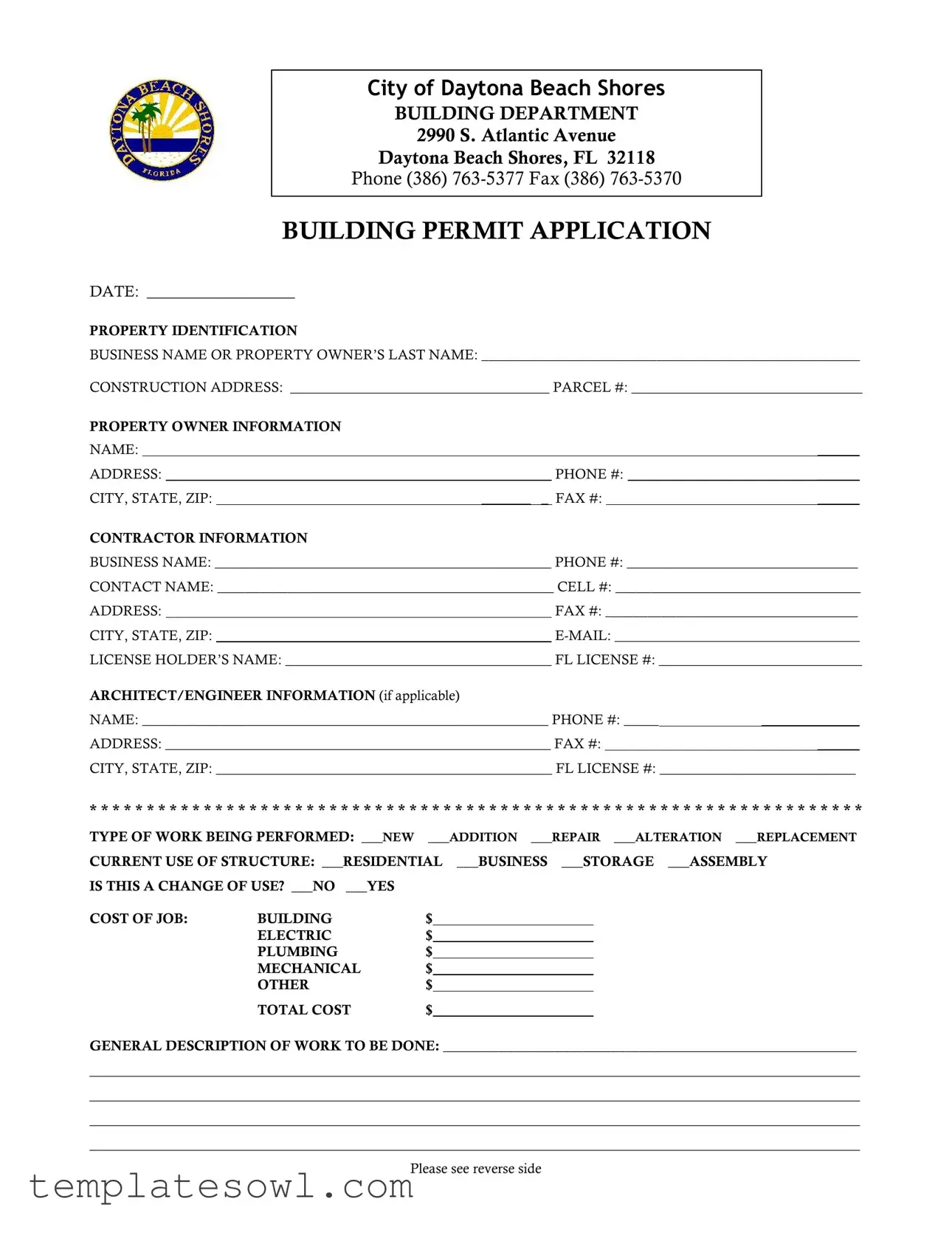City of Daytona Beach Shores
BUILDING DEPARTMENT
2990 S. Atlantic Avenue
Daytona Beach Shores, FL 32118
Phone (386) 763-5377 Fax (386) 763-5370
BUILDING PERMIT APPLICATION
DATE: ___________________
PROPERTY IDENTIFICATION
BUSINESS NAME OR PROPERTY OWNER’S LAST NAME: ______________________________________________________
CONSTRUCTION ADDRESS: _____________________________________ PARCEL #: _________________________________
PROPERTY OWNER INFORMATION |
|
|
|
|
NAME: |
|
|
|
|
______ |
ADDRESS: |
|
|
PHONE #: |
______ |
CITY, STATE, ZIP: |
|
_______ _ FAX #: |
______ |
|
|
|
|
|
|
|
|
CONTRACTOR INFORMATION
BUSINESS NAME: ________________________________________________ PHONE #: _________________________________
CONTACT NAME: ________________________________________________ CELL #: ___________________________________
|
|
|
|
|
|
|
ADDRESS: |
|
FAX #: ____________________________________ |
CITY, STATE, ZIP: |
|
E-MAIL: ___________________________________ |
LICENSE HOLDER’S NAME: ______________________________________ FL LICENSE #: _____________________________ |
ARCHITECT/ENGINEER INFORMATION (if applicable) |
|
|
|
|
NAME: __________________________________________________________ PHONE #: _____ |
______________ |
|
ADDRESS: _______________________________________________________ FAX #: |
|
______ |
|
CITY, STATE, ZIP: ________________________________________________ FL LICENSE #: ____________________________
* * * * * * * * * * * * * * * * * * * * * * * * * * * * * * * * * * * * * * * * * * * * * * * * * * * * * * * * * * * * * * * * * * * *
TYPE OF WORK BEING PERFORMED: ___NEW ___ADDITION ___REPAIR ___ALTERATION ___REPLACEMENT
CURRENT USE OF STRUCTURE: ___RESIDENTIAL ___BUSINESS ___STORAGE ___ASSEMBLY
IS THIS A CHANGE OF USE? ___NO ___YES
COST OF JOB: |
BUILDING |
$ |
|
ELECTRIC |
$ |
|
PLUMBING |
$ |
|
MECHANICAL |
$ |
|
OTHER |
$ |
|
TOTAL COST |
$ |
GENERAL DESCRIPTION OF WORK TO BE DONE: ___________________________________________________________
______________________________________________________________________________________________________________
______________________________________________________________________________________________________________
______________________________________________________________________________________________________________
______________________________________________________________________________________________________________
Please see reverse side
**BOTH OWNER AND CONTRACTOR MUST SIGN APPLICATION**
Application is hereby made to obtain a permit to do the work and installations as indicated. I certify that no work or installation has commenced prior to the issuance of a permit and that all work will be performed to meet the standard of all laws regulating construction in this jurisdiction.
OR ___ THIS IS AN AFTER-THE-FACT PERMIT (Additional permit fees will apply)
I understand that a separate permit may be required for ELECTRICAL WORK, PLUMBING, SIGNS, WELLS, POOLS, FURNACES, BOILERS, HEATERS, TANKS, AIR CONDITIONERS, EXTERIOR PAINTING, ETC.
OWNER’S AFFIDAVIT: I certify that all the foregoing information is accurate and that all work will be done in compliance with all applicable laws regulating construction and zoning.
WARNING TO OWNERS: YOUR FAILURE TO RECORD A NOTICE OF COMMENCEMENT MAY RESULT IN YOU PAYING TWICE FOR IMPROVEMENTS TO YOUR PROPERTY. IF YOU INTEND TO OBTAIN FINANCING, CONSULT WITH YOUR LENDER OR AN ATTORNEY BEFORE RECORDING YOUR NOTICE OF COMMENCEMENT.
Any person who prescribes a false statement to a Notary Public is guilty of perjury.
OWNER/AGENT SIGNATURE ________________________________________________ |
|
____ |
OWNER/AGENT’S NAME (PRINTED) _____________________________________________________________ |
STATE OF ________________________ |
COUNTY OF _________________ |
|
____ |
|
|
|
|
|
Sworn to and subscribed before me this ________ day of ___________________________ 20 _____, by
___________________________________________ who is personally known to me or has produced
_______________________________________ and who did (did not) take an oath.
_________________________________ |
My Commission Expires: |
Notary Public |
|
* * * * * * * * * * * * * * * * * * * * * * * * * * * * * * * * * * * * * * * * * * * * * * * * * * * * * * * * * * * * * * * * * * * * * * * * * * * * * * * * * * * * *
|
|
|
|
|
|
|
CONTRACTOR’S SIGNATURE ______________________________________________ |
|
|
_____ |
CONTRACTOR’S NAME (PRINTED) __________________________________________ |
|
|
__ __ |
STATE OF ___________________________ |
COUNTY OF ______________________ |
|
________ |
Sworn to and subscribed before me this ________ day of ___________________________ 20 _____, by
___________________________________________ who is personally known to me or has produced
_______________________________________ and who did (did not) take an oath.
____________________________________ |
My Commission Expires: |
Notary Public |
|
************************************************************************************************
SURETY TYPE (For office use only)
______ Current Volusia County Listing Card OR
______ Proof of Liability insurance with the City of Daytona Beach Shores listed as the certificate-holder
______ Proof of Workers’ Compensation Insurance or Exemption
______ Copy of local Business Tax Receipt (from the City the business is based in)
______ State license verified (when required)
Please see reverse side


